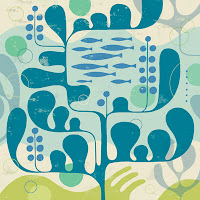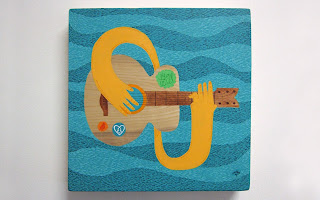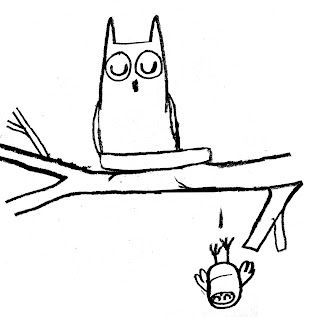I have finally done a project based on a painting by the
Jolby design team that I wanted to do for a while. It has been a lot of fun for me (and the kids).
I love the simplicity in shape and color palette. If you look closely though, there is great attention to detail on the guitar and broken line pattern that fills the background.
When I introduced the 3rd graders to the work of the Jolby team the students really got a kick out of the whimsical creatures in a lot of them. We discussed what designers do- how they make our surroundings more interesting to be in, and how they make money and a career by doing so.
I had one student ask if this was a good thing- making things that people like me and you want to buy. Like making a career of selling the products of their creativity was taboo. I loved the question.
When we looked at the above painting we discussed the relationship between the positive shapes (the guitar with hands) and the negative shape (the wavy background pattern). I talked about how this relationship is crucial to the success of a visual image. If the positive image is too small, you are left with a lot of empty negative space. If the positive shape is too simple and uninteresting, the negative shape could be as well.
Keeping that in mind, we set off to make our own versions of the painting titled 'Songs by Robin".
1. started with a 12x12 square sheet
2. cut wavy or zigzag patterns out of a 6x12 sheet of a different color
3. before gluing these pieces in place, like the birdie project, students were asked to think about spacing and direction of the strips to make the negative shapes as interesting as possible
4. glue pieces on
5. add broken line patterns to negative shape with construction paper crayons
6. create guitar body- fold 6x6 sheet in half and draw half the guitar shape
7. decide what is top and bottom, think about position on larger square, and glue in place
8. cut and add guitar neck and tuning board
9. fold sheet for hands, draw, cut, place, trim, and glue (a lot for "one" step:)
10. add stickers by cutting and gluing paper and/or with construction paper crayons
Again, the variety of guitars, decals, and overall compositions was impressive.
After we completed the project, I walked students through a self assessment. We evaluated how well they met the art standard for the lesson. I modeled this for them and they could discuss it with neighbors if they were uncertain where they scored.
We also assessed their craftsmanship and respect of others for the project. They also answered a couple questions relating to successful and unsuccessful elements of their designs.
This was a new exercise for the 3rd graders and I was very encouraged with how well they did with it. After the class left I went through and checked how they assessed themselves and assessed each of them myself on the same sheet. These will get returned to their teachers to give them more support/evidence for the students' art grades.
An extra note of thanks goes out to Josh and Colby of Jolby for graciously donating a couple copies of their new kids' book,
the King's 6th Finger, to our school library and my classroom reading center, as well as a few stickers and bookmarks that I will be using as good behavior rewards. I shared these with my 3rd grade classes today and they were the cat's meow!














